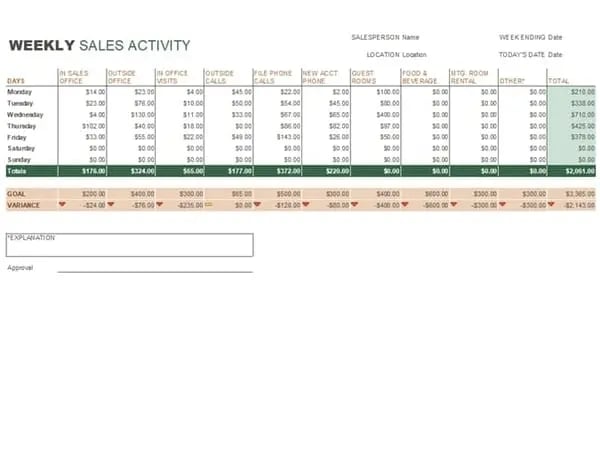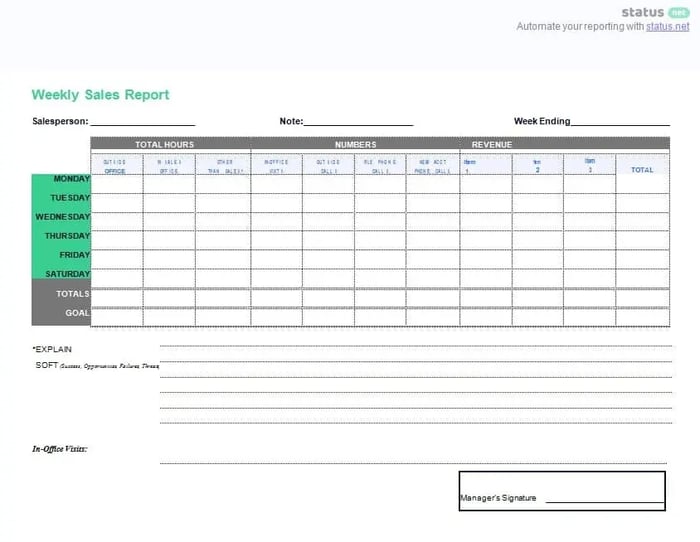According to LinkedIn’s 2020 State of Sales Report, buyers are becoming increasingly less responsive, with 44% of salespeople reporting a decrease in responsiveness to outreach. This research also indicates sales cycles are increasing, with 44% of salespeople saying their customers buying cycles have increased.
For businesses looking to quickly pivot and adopt new strategies to remain competitive, understanding relevant data is more important than ever. With so much uncertainty surrounding the future state of business sales organizations are relying on data to make informed decisions. 56% of sales reps are currently using data to prospect, and 49% of reps are using data to determine which industries to target with their sales efforts.
Are you looking to incorporate more data-driven decisions into your sales process? If so, you may want to consider implementing or re-vamping your weekly sales reporting.
These reports don’t need to incorporate every sales metric under the sun to be meaningful. In fact, we recommend focusing on the data points that truly move the needle for your business to avoid overwhelm and busywork for your reps.
Weekly sales reports can typically be compiled from information that can be easily found in your CRM. Essentially, the weekly sales report should serve as a roadmap for your reps, keeping the most pertinent data your sales team needs front and center through consistent visibility and analysis.
When creating your weekly sales report, it is important to have the following points clearly defined and understood:
- Target audience — Who benefits from receiving this information? The answer to this question can help define what information is included in the report, along with how it should be formatted. For some teams, their weekly sales reports are for communicating sales performance to company leadership. For others, their weekly sales report is an internal tool specifically for reps to track and improve their own performance.
- Determine which data points to measure — Which KPIs do you want to have the most visibility? Again, simple is best here so your reps aren’t so preoccupied with reporting that it impacts their ability to sell. Define what data points are critical to understand for your business. We also provide some suggestions below.
- Necessary context — Simply providing numbers without context is not helpful. Aim to provide background information that helps tell the full story of your numbers. For example, if you focus on selling to a European customer base and are reporting on sales activity that happened during a major holiday week for your prospects, that would be helpful context to include if numbers are lower than usual.
According to HubSpot Senior Sales Manager Mike Fradette, weekly sales reports are a critical part of his team’s workflow. He says:
"Sales reps want to know where they stand. The data provided by weekly sales reports surface key areas for improvement that uncover coaching opportunities.
Reviewing weekly sales data as a team is also a great benchmarking exercise. It gives the entire team a look at what the top reps are doing and provides a line of sight into where they spend their time and how they manage their business. This is especially helpful for new or struggling reps who are refining their approach and developing new skills and habits."
Unsure what to include in your team’s weekly sales report? Here are some meaningful KPI’s to consider.
Weekly Sales Report Format
1. Total Pipeline Generated
This measures the pipeline creation rate as a result of meetings held by each rep. For a weekly sales report, your reps can include the pipeline creation rate for that week and month to date.
2. Total Deal Creation
Total deal creation tracks the total deals created. In the weekly sales report, each rep can provide their deals created for each day along with totals for the week and month to date.
3. Weekly Sales Calls
Each week, reps should also report on the outcomes of their sales calls for the week. This can include the following information:
- Number of calls made
- Number of voicemails left
- Number of prospects who didn’t answer
- Number of connections
4. Capacity Work Rate
Assuming many sales teams are working to meet monthly quotas, the capacity work rate tracks how many unique potential customers (or companies for B2B salespeople) each rep comes in contact with during their 30-day sales period.
5. Lead Response Time
On average, how long does it take leads to respond when contacted by your reps? Tracking this information can be incredibly helpful for understanding fluctuations in cycle time, which can impact your sales strategy.
6. Closed-Won Deals
How many wins have your reps had each week? Whether you are focused on the number of deals they have closed, or the dollar amount brought in from closed deals each week, celebrate those wins often to keep the momentum going and to provide valuable learnings to the rest of your team about what tactics are and aren’t working.
Weekly Sales Report Template
If you or your reps need a little help getting started, here are some templates that can support the weekly sales reporting process.
HubSpot Sales Dashboard

This free reporting template is available in Microsoft Excel and Google Sheets formats. Users can use this dashboard to visually keep track of pertinent sales data for weekly and monthly reporting.
Weekly Sales Activity Report

This Excel-ready weekly sales activity report helps reps document their weekly activities in one place, making for easy reporting.
Weekly Status Report Template

This straightforward, easy-to-use template is great for those new to sales reporting and is available to download in both Microsoft Word and Excel formats.
Regularly analyzing and leveraging data is an important activity for any sales team. To learn more about what sales metrics you should be tracking, check out this post.
.png?width=112&height=112&name=Image%20Hackathon%20%E2%80%93%20Square%20(14).png)


![10 Important Sales Analysis Reports [+ 4 Sales Report Templates]](https://53.fs1.hubspotusercontent-na1.net/hubfs/53/Sales-Analysis-Reports-1-20241007-6831164.webp)
.jpg)
